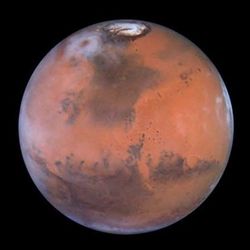Spirit, Opportunity Rovers Completed Original Missions In
2004
A patch of Martian soil analyzed by NASA's rover Spirit is so
rich in silica it may provide some of the strongest evidence yet
that ancient Mars was much wetter than it is now. The processes
that could have produced such a concentrated deposit of silica
require the presence of water.

The rover science team heard from a colleague during a recent
teleconference that the alpha particle X-ray spectrometer, a
chemical analyzer at the end of Spirit's arm, had measured a
composition of about 90 percent pure silica for this soil,
according to the agency.
"You could hear people gasp in astonishment," said Steve Squyres
of Cornell University in Ithaca, NY and principal investigator for
the Mars rovers' science instruments. "This is a remarkable
discovery. And the fact that we found something this new and
different after nearly 1,200 days on Mars makes it even more
remarkable. It makes you wonder what else is still out there."
Spirit's miniature thermal emission spectrometer observed the
patch of soil, and Steve Ruff of Arizona State University, Tempe,
noticed its spectrum showed high silica content. The team has
already laid out plans for further study of the soil patch and
surrounding deposits.
A thermal emission spectrometer (TES) is both an instrument and
a technique. It measures the thermal infrared energy (heat) emitted
from a planet and is capable of producing two-dimensional images of
Mars' surface, according to Arizona State University.
While exploring a low range of hills inside a basin named Gusev
Crater, the rover found other evidence of water, such as patches of
water-bearing, sulfur-rich soil; alteration of minerals; and
evidence of an explosive volcano.
 "This is some of the
best evidence Spirit has found for water at Gusev," said Albert
Yen, a geochemist at NASA's Jet Propulsion Laboratory, Pasadena,
CA.
"This is some of the
best evidence Spirit has found for water at Gusev," said Albert
Yen, a geochemist at NASA's Jet Propulsion Laboratory, Pasadena,
CA.
Some possible explanations for the silica could have been
interaction of soil with acid vapors produced by volcanic activity
in the presence of water or perhaps water in a hot spring
environment. This latest discovery adds compelling new evidence
that conditions, at some point in the planet's history, might have
been able to sustain life.
"What's so exciting is that this could tell us about
environments that have similarities to places on Earth that are
clement for organisms," said David Des Marais, an astrobiologist at
NASA's Ames Research Center, Moffett Field, CA.
Spirit and its twin rover, Opportunity, actually completed their
original three-month missions in April 2004. But, they are still
operating, although their age is starting to show. One of Spirit's
six wheels no longer rotates, so it leaves a deep rut as it drags
through the soil.
However, age does have its benefits: those ruts are what exposed
several patches of bright soil, leading to some of Spirit's biggest
discoveries at Gusev, including this one.
"This unexpected new discovery is a reminder that Spirit and
Opportunity are still doing cutting-edge exploration more than
three years into their extended missions. It also reinforces the
fact that significant amounts of water were present in Mars' past,
which continues to spur the hope that we can show that Mars was
once habitable and possibly supported life," said Doug McCuistion,
director of NASA's Mars Exploration Program.
The newly discovered patch of soil has been dubbed "Gertrude
Weise," after a player in the All-American Girls Professional
Baseball League, according to Ray Arvidson of Washington University
in St. Louis, deputy principal investigator for the rovers.
"We've looked at dozens of disturbed soil targets in the rover
tracks, and this is the first one that shows a high silica
signature," said Ruff, who last month proposed using Spirit's
miniature thermal emission spectrometer to observe this soil.
The TES provides mineral composition information from a
distance. The discovered silica prompted a decision this month to
drive Spirit close enough to touch the soil with the alpha particle
X-ray spectrometer (APXS).
 The APXS determines the elemental
chemistry of rocks and soils using alpha particles and X-rays,
according to NASA.
The APXS determines the elemental
chemistry of rocks and soils using alpha particles and X-rays,
according to NASA.
Silica commonly occurs here on Earth as the crystalline mineral
quartz and is the main ingredient in window glass. The Martian
silica at the Gertrude Weise patch is non-crystalline, and has no
detectable quartz.
"This discovery has driven home to me the value of in-depth,
careful exploration," Squyres said. "This is a target-rich
environment, and it is a good thing we didn't go hurrying through
it."
Meanwhile, on the other side of the planet, Opportunity has been
exploring the Victoria Crater for about eight months.
"Opportunity has completed the initial survey of the crater's
rim and is now headed back to the area called Duck Bay, which may
provide a safe path down into the crater," said John Callas,
project manager for the rovers at JPL, a division of the California
Institute of Technology, Pasadena, which manages the Mars
Exploration Rover project for NASA.
 Aero-News: Quote of the Day (04.28.25)
Aero-News: Quote of the Day (04.28.25) ANN's Daily Aero-Term (04.28.25): Decision Altitude (DA)
ANN's Daily Aero-Term (04.28.25): Decision Altitude (DA) ANN's Daily Aero-Linx (04.28.25)
ANN's Daily Aero-Linx (04.28.25) Airborne-Flight Training 04.24.25: GA Refocused, Seminole/Epic, WestJet v TFWP
Airborne-Flight Training 04.24.25: GA Refocused, Seminole/Epic, WestJet v TFWP Aero-News: Quote of the Day (04.29.25)
Aero-News: Quote of the Day (04.29.25)





